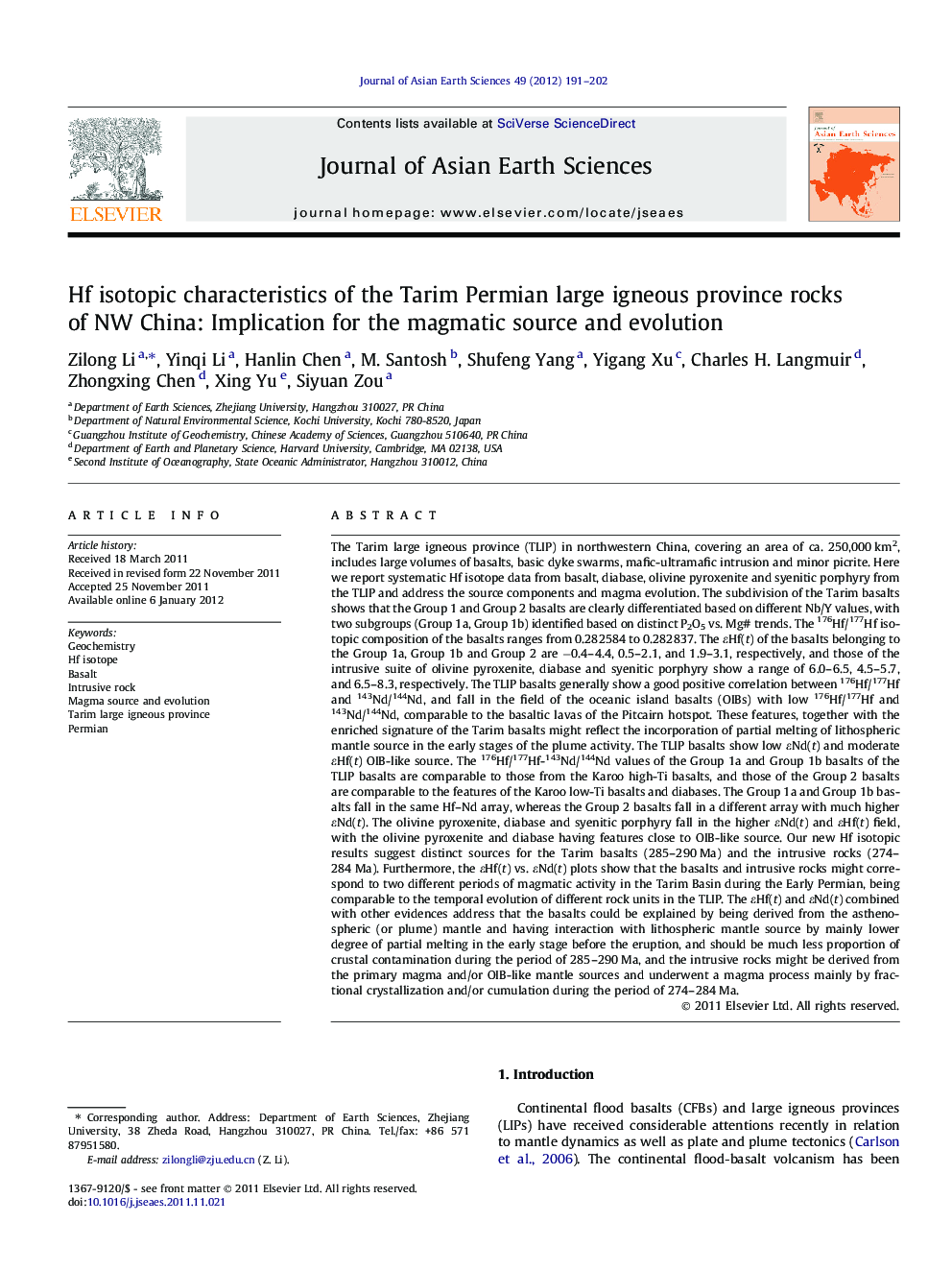| کد مقاله | کد نشریه | سال انتشار | مقاله انگلیسی | نسخه تمام متن |
|---|---|---|---|---|
| 4731513 | 1640415 | 2012 | 12 صفحه PDF | دانلود رایگان |

The Tarim large igneous province (TLIP) in northwestern China, covering an area of ca. 250,000 km2, includes large volumes of basalts, basic dyke swarms, mafic-ultramafic intrusion and minor picrite. Here we report systematic Hf isotope data from basalt, diabase, olivine pyroxenite and syenitic porphyry from the TLIP and address the source components and magma evolution. The subdivision of the Tarim basalts shows that the Group 1 and Group 2 basalts are clearly differentiated based on different Nb/Y values, with two subgroups (Group 1a, Group 1b) identified based on distinct P2O5 vs. Mg# trends. The 176Hf/177Hf isotopic composition of the basalts ranges from 0.282584 to 0.282837. The εHf(t) of the basalts belonging to the Group 1a, Group 1b and Group 2 are −0.4–4.4, 0.5–2.1, and 1.9–3.1, respectively, and those of the intrusive suite of olivine pyroxenite, diabase and syenitic porphyry show a range of 6.0–6.5, 4.5–5.7, and 6.5–8.3, respectively. The TLIP basalts generally show a good positive correlation between 176Hf/177Hf and 143Nd/144Nd, and fall in the field of the oceanic island basalts (OIBs) with low 176Hf/177Hf and 143Nd/144Nd, comparable to the basaltic lavas of the Pitcairn hotspot. These features, together with the enriched signature of the Tarim basalts might reflect the incorporation of partial melting of lithospheric mantle source in the early stages of the plume activity. The TLIP basalts show low εNd(t) and moderate εHf(t) OIB-like source. The 176Hf/177Hf-143Nd/144Nd values of the Group 1a and Group 1b basalts of the TLIP basalts are comparable to those from the Karoo high-Ti basalts, and those of the Group 2 basalts are comparable to the features of the Karoo low-Ti basalts and diabases. The Group 1a and Group 1b basalts fall in the same Hf–Nd array, whereas the Group 2 basalts fall in a different array with much higher εNd(t). The olivine pyroxenite, diabase and syenitic porphyry fall in the higher εNd(t) and εHf(t) field, with the olivine pyroxenite and diabase having features close to OIB-like source. Our new Hf isotopic results suggest distinct sources for the Tarim basalts (285–290 Ma) and the intrusive rocks (274–284 Ma). Furthermore, the εHf(t) vs. εNd(t) plots show that the basalts and intrusive rocks might correspond to two different periods of magmatic activity in the Tarim Basin during the Early Permian, being comparable to the temporal evolution of different rock units in the TLIP. The εHf(t) and εNd(t) combined with other evidences address that the basalts could be explained by being derived from the asthenospheric (or plume) mantle and having interaction with lithospheric mantle source by mainly lower degree of partial melting in the early stage before the eruption, and should be much less proportion of crustal contamination during the period of 285–290 Ma, and the intrusive rocks might be derived from the primary magma and/or OIB-like mantle sources and underwent a magma process mainly by fractional crystallization and/or cumulation during the period of 274–284 Ma.
Journal: Journal of Asian Earth Sciences - Volume 49, 30 April 2012, Pages 191–202